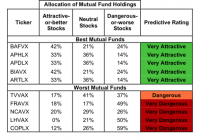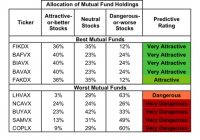Best And Worst Q3’15: All Cap Value ETFs, Mutual Funds And Key Holdings
Summary All Cap Value style ranks fifth in Q3’15. Based on an aggregation of ratings of 0 ETFs and 257 mutual funds. BAFVX is our top-rated All Cap Value mutual fund and COPLX is our worst-rated All Cap Value mutual fund. The All Cap Value style ranks fifth out of the twelve fund styles as detailed in our Q3’15 Style Ratings for ETFs and Mutual Funds report. It gets our Neutral rating, which is based on aggregation of ratings of 0 ETFs (no All Cap Value ETFs are currently under coverage) and 257 mutual funds in the All Cap Value style. See a recap of our Q2’15 Style Ratings here. Figure 1 shows the five best and worst rated All Cap Value mutual funds. Not all All Cap Value style mutual funds are created the same. The number of holdings varies widely (from 21 to 521). This variation creates drastically different investment implications and, therefore, ratings. Investors seeking exposure to the All Cap Value style should buy one of the Attractive-or-better rated ETFs or mutual funds from Figure 1. Figure 1: Mutual Funds with the Best & Worst Ratings – Top 5 (click to enlarge) * Best mutual funds exclude funds with TNAs less than $100 million for inadequate liquidity. Sources: New Constructs, LLC and company filings LSV U.S. Managed Volatility Fund (MUTF: LSVMX ) (MUTF: LVAMX ) is excluded from Figure 2 because its total net assets are below $100 million and do not meet our liquidity minimums. The Brown Advisory Value Equity Fund (MUTF: BAFVX ) is the top-rated All Cap Value mutual fund and earns a Very Attractive rating. The Copley Fund (MUTF: COPLX ) is the worst-rated All Cap Value mutual fund and earns a Very Dangerous rating. Oracle Corporation (NYSE: ORCL ) is one of our favorite stocks held by All Cap Value funds and earns our Attractive rating. Over the past decade, the company has grown after-tax profit ( NOPAT ) by 15% compounded annually. Oracle currently earns a top quintile return on invested capital ( ROIC ) of 25%. Despite one of the highest ROIC’s in the business and consistent profit growth, ORCL remains undervalued. At its current price of ~$39/share, Oracle has a price to economic book value ( PEBV ) ratio of 1.1. This ratio implies that the market expects Oracle’s profits to grow by no more than 10% over current levels for the remainder of its corporate life. If Oracle can grow NOPAT by just 5% compounded annually for the next ten years , the stock is worth $53/share – a 36% upside. Intersil (NASDAQ: ISIL ), a previous Danger Zone pick , is one of our least favorite stocks held by All Cap Value funds and earns our Very Dangerous rating. Since 2009, Intersil’s NOPAT has fallen by 31% compounded annually. The company currently earns a bottom quintile ROIC of 1% and has a NOPAT margin of only 2%. Such a low margin leaves little room for error in the highly competitive semiconductor industry. With such poor fundamentals, Intersil’s stock, despite being down 18% year to date, remains overvalued. To justify the current price of $11/share, Intersil must grow NOPAT by 30% compounded annually for the next 19 years. Betting on double digit NOPAT growth for such an extended period of time is overly risky given the past profits profile of this company. Investors should, instead, invest in quality stocks like Oracle. Figure 2 shows the rating landscape of all All Cap Value mutual funds. Figure 2: Separating the Best Mutual Funds From the Worst Funds (click to enlarge) Sources: New Constructs, LLC and company filings D isclosure: David Trainer and Max Lee receive no compensation to write about any specific stock, style, style or theme. Disclosure: I/we have no positions in any stocks mentioned, and no plans to initiate any positions within the next 72 hours. (More…) I wrote this article myself, and it expresses my own opinions. I am not receiving compensation for it. I have no business relationship with any company whose stock is mentioned in this article.

